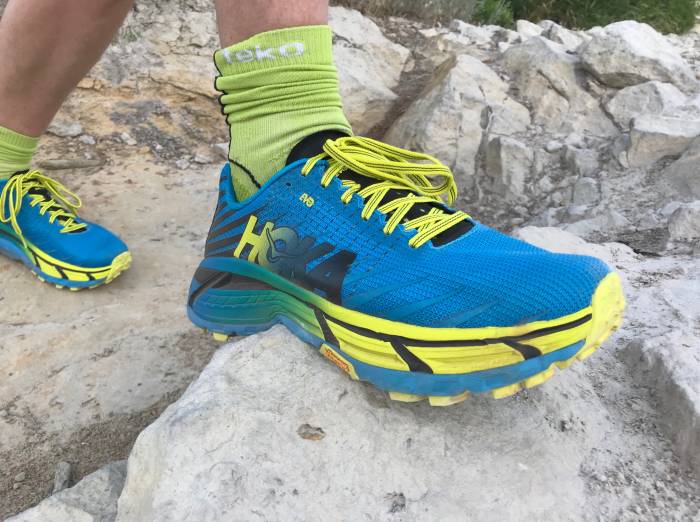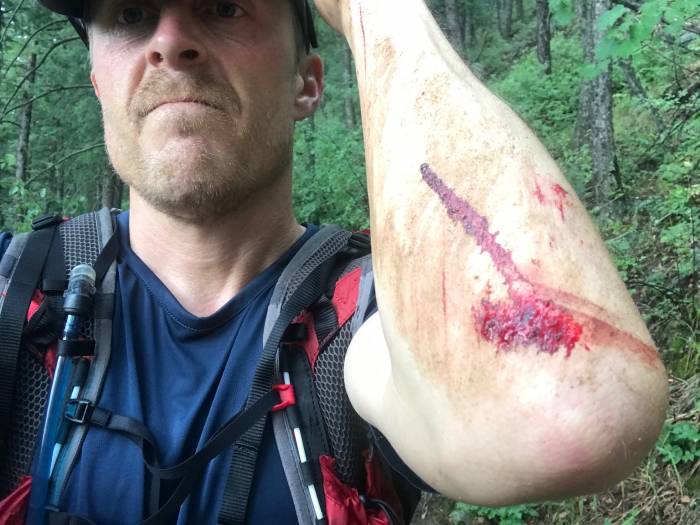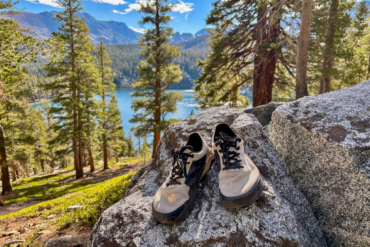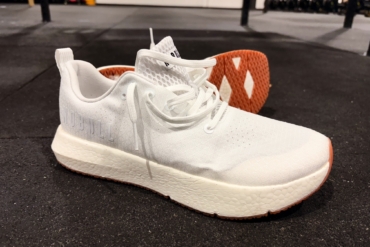HOKA ONE ONE introduced the EVO Mafate as a well-cushioned trail running shoe, light enough to propel elite runners to the podium. I strapped on a pair and hit my local trails in many long training runs for this review.

When it comes to trail running shoes, I’m a bit of a reluctant adapter to tall stack heights. I do much of my training in mid- to low-stack shoes and have had a few bad experiences in taller shoes on rugged trails in the past.
But with a Leadville 100 Trail Run looming on the horizon, I made it a mission to find a protective shoe capable of slogging big miles on a sometimes technical terrain.
Enter the HOKA ONE ONE EVO Mafate ($170), available for men and women. The model grabbed my attention after Jim Walmsley wore it in his Western States victory this spring. I’m no elite athlete, but if it was fast enough for Walmsley, burly enough for Western States, and protective enough for my wimpy feet (the men’s have a 33-mm heel stack), I might have found my ruby slipper. Could it be enough to get me across the finish line under my 24-hour goal?
With lots of training runs to gear up for Leadville, I had plenty of time to put them to the test before the August 18 race day.
In short: The Evo Mafate is a well-cushioned trail shoe that nonetheless gives runners reasonable proprioception. And while it managed moderately technical trails and easy trails well, I found it a little too tall for more “black diamond” terrain where a shorter-stack shoe gives more precise foot placement. Even with this caveat, it’s one of my favorite trail running shoes of 2018.
HOKA ONE ONE EVO Mafate Trail Shoe Review
The EVO Mafate sits in the middle of HOKA’s line with what it calls a “balanced” cushion and neutral stability. The men’s has a 33- to 29-mm heel-toe stack height (4-mm drop) and weighs a scant 9.6 ounces.
Blasting along my regular training routes, I found the shoe remarkably fast given the significant amount of padding. During my first run in the shoe, I knocked out an early personal best on the Matthew Winters-Red Rocks loop in the foothills near Denver. The loop runs over a technical section on Dakota Ridge that really tests foot placement.

I was impressed. While a shorter-stack shoe like the HOKA Torrent, Salomon Sense Ride, or even the wide Altra Timp gave a little more precision in the off-camber, rocky, sloping terrain, the EVO Mafate held its own.
And I found that the light-but-cushioned shoe paid dividends in speed because my feet simply didn’t hurt.
Foot Wimp? Yeah, Guilty
I’ve run quite a few ultras over the years. I’ve grown out of the barefoot movement and come to embrace a variety of shoes, from minimal for short training runs to very cushioned for long days.
And in every ultra I’ve run, my feet have been a weak link. I lost seven toenails in my first ultra: the Trans Rockies Run back in 2012. Since then, I’ve found better ways to manage foot pain.
Through my spring and summer training for the upcoming Leadville 100, I’ve found a few shoes that I hope will keep the pain to a minimum during the race. And at the top of this list is the EVO Mafate, a shoe I expect to wear for at least a large part of Leadville.
EVO Mafate: Strengths
I find a lot to love in the EVO Mafate. It’s fast. It’s protective. The upper let my foot breathe well in warm weather and drains quickly. And it has a burly, aggressive outsole that is really grippy on everything from mud to rock.
On moderately rocky trails, I found the shoe protected my foot well from sharp edges. On smooth trails, it gives a lot of rebound and moves fast. It’s remarkably light, and thus let me cover big training miles (20-plus miles per day) with little pain.
Weaknesses
This is, in my opinion, a tall-stack shoe. And with that, it loses some precision in foot placement. On sloping, tricky terrain, the outsole bites in but twists somewhat when on edges. That’s to be expected with a tall shoe and, to me, just part of the compromise.
But for people planning really technical runs or off-trail climbing, it’s worth noting that these won’t edge well on rocks and aren’t intended as an approach shoe.
Finally, a small note on the aggressive sole: While it’s great and grabby, I took a pretty nasty fall after a downhill toe stub. The shoe really grabbed, and I couldn’t recover from the fall.
I don’t really blame the shoe, but well, it happened. Honestly, it could have happened wearing any shoes, but the aggressive soles here, especially the toe cap, didn’t forgive my error. Also worth noting is that it protected my toe pretty well, and I was left with nothing worse than a bruised nail and bleeding elbow and knee (and ego).
Fit
The EVO Mafate fit my modestly wide forefoot well. I found it pretty true to size.
The upper held my foot snugly in the heel and midfoot. I felt secure enough to really let it rip downhill, with my heel locked in place. While the forefoot isn’t really wide enough to let my toes splay, it is still comfortable.
My toes never feel crowded in this shoe. It’s narrower than most shoes from Altra, for example, but the compromise allows it to be more precise in foot placement.
Evo Mafate: A Shoe for Big Miles
Ultimately, this is one of my favorite trail running shoes in my current trail running quiver. I will definitely run in it in the Leadville 100 in two weeks, and I expect it to be my top mileage shoe in the race. Others likely to serve important roles are the HOKA ONE ONE Torrent and Salomon Sense Ride on more technical portions of the race, and the Altra Olympus late in the game.
If you’re wondering, I’m a middle-of-the-pack runner. My goal of finishing under 24 hours will be a significant challenge. Like a lot of other runners in this medium-slow range, I expect to face a lot of pain.
With a lot of protection, I hope the EVO Mafate will help ease a little of the pain cave by keeping my feet just a little happier on every excruciating step.












